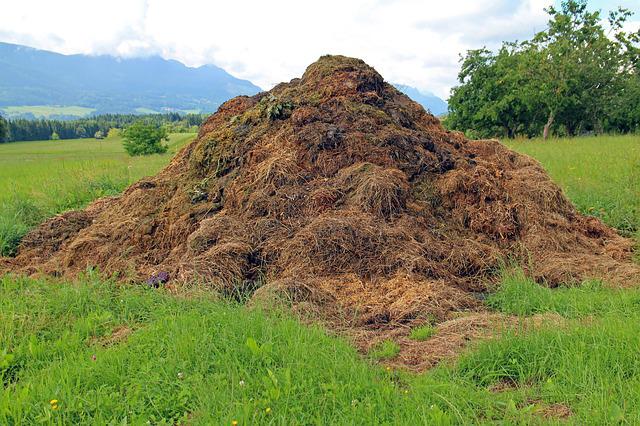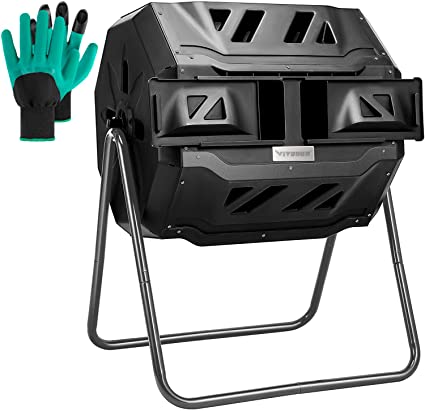Compost needs to be mixed up periodically to ensure the right balance of components. When you turn your compost pile, you move things around in it, like tossing a salad. It’s a pretty easy process, and it is important to ensure that your compost continues to decompose correctly without rotting. Let’s learn how often to turn compost, how, when, and why.
How Often To Turn Compost
How often you should turn your compost depends a bit on the type of compost system that you have.
You typically want to turn your compost every 3 to 5 days in a tumbler or worm composting system. You want to turn it every 3 to 7 days for a compost pile. The older the compost, the less likely you need to turn it.
If you turn it too frequently, it may never reach the temperature you want for effective decomposition.
Signs That You Need to Turn Your Compost
The smell is a big sign that you have gone too long without turning your compost. If your compost starts to smell, you probably need to turn it. That is often a sign that you have moved to anaerobic decomposition and your compost is basically rotting rather than degrading with the help of the helpful microorganisms we are looking for.
The bad news is that if you’ve gone this long, turning it may actually make the smell worse for a while. You might want to turn it more frequently next time.
How to Turn Compost
When you turn your compost, you are basically looking to move things on the inside of the pile back to the outside and vice versa. You are introducing oxygen throughout the compost, spreading the green and brown material throughout, and, hopefully, making a robust environment for the microorganisms that help us with our compost.
Turning is pretty easy but varies a bit depending on the type of compost system you have.

Compost Aerator Tool
No matter what compost system you have, you can use a compost aerator tool like this to turn your compost. This compost turning tool is basically a type of crank that allows you to dig into your compost pile and move material around. The nice part about it is that you can truly move material from the middle of your pile to the outer part of your pile.
There are a variety of sizes of these compost cranks depending on how you need to use them. They will work on almost any type of compost pile (except a tumbler which doesn’t need one.) Compost aerator tools are great for worm compost bins (vermicomposting).

Turning a Compost Pile or Plastic Compost Bin
If you have a compost pile, you can take a pitchfork or shovel and mix up the compost pile. You want to get things in the middle of the compost pile and move them to the outside and vice versa. The mixing also helps ensure that the whole pile has the oxygen and moisture needed for good composting.
People who have enough land sometimes, they like to have multiple compost bins. When they turn the compost, they move a pile from one bin to another. Doing that effectively turns it. Otherwise, you can just mix it like you would if you were tossing a salad.

Turning a Compost Tumbler
One fairly easy way of mixing a compost pile is by composting it in a tumbler. A tumbler is intended to help mix compost in the same way that a concrete truck turns concrete to keep it from hardening. This is probably one of the easier ways to turn the compost.
Turning Your Worm Compost Pile
You still need to turn your compost if you’re using a worm system for composting, called vermicomposting. When you do it, you want to ensure that you don’t harm the worms or send them flying all over. These systems tend to be in dedicated bins to keep the worms close to the compost (don’t want them wandering off too far.)
The same concepts apply. You can use a small shovel to turn the compost. You can also use a mechanical aerator that looks like a giant corkscrew like this one from Amazon. It looks scary for the worms, but it won’t hurt them, and it will mix up your compost without sending everything flying.
Benefits of Turning Your Compost
A big part of composting is ensuring that everything is in the right balance (kind of makes it sound zen-like.) You are looking to create the right conditions for the microorganisms (or microorganisms, too, in the case of worms) to thrive. This means that you need four major components:
- Green Material – This is material that is rich in nitrogen
- Brown Material – This is carbon-rich material
- Oxygen – Oxygen (in the form of air) is needed by the bacteria to thrive. Without it, rather than decomposing, your pile is more rotting which will stink, attract pests and repel neighbors.
- Moisture/Water – This is a Goldilocks material; you want enough, not too little, and not too much. Like a moist sponge
You are also looking to give your pile time to heat up. The decomposition occurs best in an ideal temperature band which occurs with the right mix of materials and organisms.
As time goes on, the bacteria eat up the scraps and such that you have added to the pile. This causes the pile to start to, more or less, collapse in the middle. That means there is less space for air, which they are also using up. If your pile is too moist, then that takes up some of the space, too – the moisture pushes the air out. None of this makes for a good environment.
Turning your compost pile, make more small pockets for the air, move the composting material around, and move the moisture around.
This helps you create the right environment for your compost pile.
Turning your compost pile with the right frequency:
- Aerates your compost pile – Basically, it keeps that oxygen throughout your compost pile. This ensures that the worms, bacteria, and other compost-friendly organisms in your pile have the right amount of air and moisture
- Prevents Localized Rotting – Without turning your pile, you could see rotting in part or all of your pile.
- Redistributes Moisture – This helps to prevent too much moisture in your compost.
- Spreads Out the Heat – The middle of your pile will typically warm up the most (it’s the best insulated). While you want your compost to be heated enough, turning helps to spread that heat out.
- Lets You See Your Success – It’s a small thing, but it’s a lot of fun to turn over that pile and see the “black gold” that you’re making!
Can You Turn Your Compost Too Much?
If turning compost is good, then turning it more much be great right?
Not so much. Part of the purpose of turning the compost is to spread out the heat and to reaerate the compost for the bacteria and other microbes. If you compost too much, your compost never has time to heat up. Without the heat, it can’t compost completely and you will actually slow down the composting process.
You want to give your compost time to “cook” and warm up properly. Turn it too much and that never happens.
How Often Should You Turn Your Compost
How often depends a bit on the type of compost pile that you have and how old it is. Basically, it’s 1-2 times per week. Turning is an important part of maintaining a healthy compost pile.
